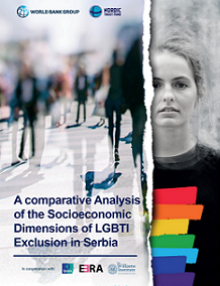The World Bank’s research on LGBTI exclusion has been focused on addressing an environment of sparse data, as well as raising awareness about the adverse socioeconomic effects of exclusion based on sexual orientation and gender identity (SOGI). Recently, we went a step further and tested a survey methodology that allows robust comparisons between the lives of LGBTI people and the general population.
The report A Comparative Analysis of the Socioeconomic Dimensions of LGBTI Exclusion in Serbia is based on an adaptation of the EU’s Survey on Income and Living Conditions (SILC) instrument; a standardized household survey used regularly in Serbia to collect data from the general population on income, poverty, social exclusion, and living conditions.
What makes the methodology unique?
- It is one of the first efforts globally to frame the challenges faced by LGBTI people in the context of the experiences of the general population.
- The original SILC data was weighted to the target demographics in the LGBTI sample. Then, a sample matching procedure was conducted using a covariate balancing propensity score to allow a comparison between the two samples.
- The LGBTI SILC used key sections of the SILC questionnaire and complemented them with a set of additional questions to gain a better understanding of the life of LGBTI people in Serbia.
In total, 998 LGBTI people responded to the online survey and the data provide new insights on differences in the socio-economic outcomes of LGBTI people and a demographically similar subset of the general population.
The findings show that certain socioeconomic outcomes of LGBTI people are worse than the general population’s. For example, the median household income for the LGBTI sample (€489) is less than for the comparable sample of the general population (€628). While there is no significant difference in the at-risk-of-poverty rate, factors such as age and education that reduce the rate in the general population do not reduce the rate in the LGBTI sample. In the general population, persons in the youngest age group have the highest rate (21 percent), which declines to 9 percent for individuals over 35 years of age. However, LGBTI respondents, have similar at-risk-of-poverty rates across age groups, and the rate for LGBTI respondents over 35 is almost twice that of the general population (17 percent).
Despite existing legal protections against discrimination, LGBTI people frequently experience discrimination in the workplace. Transgender respondents are particularly vulnerable, two-thirds (62 percent) of them experience negative comments or conduct at work because of their gender identity. Importantly, the data links experiences of discrimination with lower socio-economic outcomes. The rates of material deprivation are twice as high for LGBTI respondents who experienced workplace discrimination in the past five years (52 percent) compared to those who did not (25 percent) and the general population (27 percent). The median personal income of LGBTI respondents who experienced workplace discrimination is €236, which is less than that of LGBTI respondents who did not experience discrimination (€260) and equal to that of the general population (€236).
The survey findings confirm the European Commission’s recommendation that Serbia needs “to step up measures to protect the rights of persons facing discrimination, including LGBTI persons, persons with disabilities, persons with HIV/AIDS and other vulnerable individuals.” A Comparative Analysis of the Socioeconomic Dimensions of LGBTI Exclusion in Serbia provides new data points on implementation gaps and can inform the country’s response to the European Commission’s recommendations. The data can also be used as a baseline for future action plans to measure the impact of reforms.
Click here to learn more about the World Bank’s work on SOGI inclusion.


